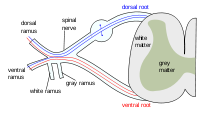
Photo from wikipedia
BACKGROUND Anterior cervical discectomy (ACD) is one of the most common spinal surgeries. Although rare, iatrogenic vertebral artery injuries (VAIs) are potentially life-threatening. Risk factors are anatomic, operative, and pathologic.… Click to show full abstract
BACKGROUND Anterior cervical discectomy (ACD) is one of the most common spinal surgeries. Although rare, iatrogenic vertebral artery injuries (VAIs) are potentially life-threatening. Risk factors are anatomic, operative, and pathologic. We report a rare case of iatrogenic VAI during ACD and successful endovascular treatment with no long-term complications. We also review the literature on all VAIs associated with ACD and fusions. Risk factors and the safety and effectiveness of various management modalities are discussed. CASE DESCRIPTION A 64-year-old patient sustained iatrogenic right VAI during ACD, followed by the delayed formation of a vertebral artery pseudoaneurysm and subsequent rehemorrhage. The patient recovered well with no long-term neurologic sequelae. This case is unusual because the pseudoaneurysm was not apparent on early computed tomography angiography. There is currently no consensus regarding the appropriate intraoperative management for iatrogenic VAIs. Described treatment modalities include direct repair, tamponade, and endovascular procedures. CONCLUSIONS Delayed pseudoaneurysm formation after iatrogenic VAI can occur. Endovascular embolization can be a safe treatment alternative to surgical repair.
Journal Title: World neurosurgery
Year Published: 2017
Link to full text (if available)
Share on Social Media: Sign Up to like & get
recommendations!